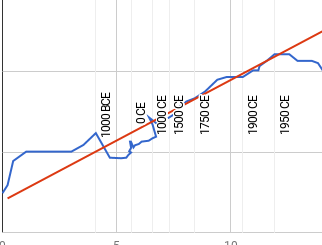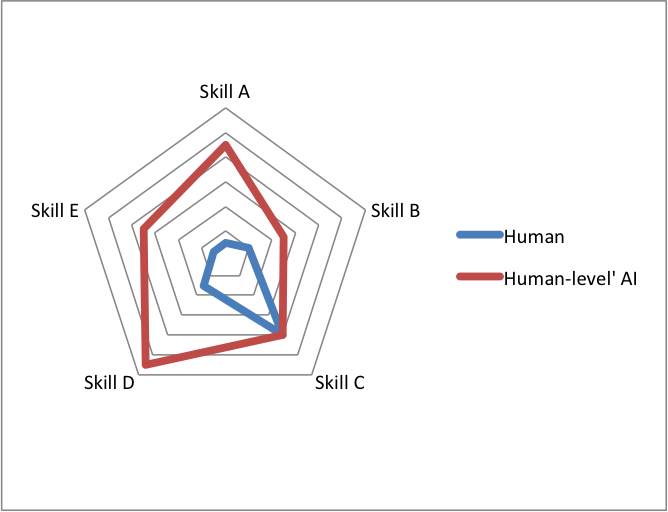We very roughly estimate that the annual cost of reducing the probability of human extinction by 0.01% is within the range of $1.1 billion to $3.5 trillion.
Introduction
This article is intended to be usable in a Cost-Benefit Analysis (CBA) analysis of extinction risk mitigation. It explores the costs of such efforts. A corresponding article (forthcoming) will explore the benefits. The focus on extinction risk, rather than the broader concept of existential risk, is due to the approach taken by the benefits article.
Ultimately the purpose of this exercise is to analyse the extinction risk arising from artificial superintelligence (ASI). However, the analysis does not take an ASI-specific approach. Although certain parts of the exercise will focus on this particular risk, the analysis is also more generally applicable to other sources of extinction risk.
Motivation
Although estimates of the probability of human extinction are highly subjective and uncertain, the probability of an existential disaster—a broader category—occurring before 2100 is typically estimated (p. 15) to be 10–20%. An earlier survey focusing only on extinction risk estimated a probability of 19%. Even if these estimates are highly mistaken, a probability of even 1% might be well worth mitigating.
CBA can inform decisions of whether to mitigate extinction risk, and provide estimates of how much expenditure can be justified. CBA is a widely used framework for assessing projects, policies, and decisions. By reducing complex issues to aggregable monetary figures, CBA “translates” difficult questions into a form useful to decision makers who may only possess surface knowledge of the relevant subject matter. This article may be useful to such policymakers who are faced with decisions about mitigating extinction risk.
Approach
It is hard to apply CBA to the risk of extinction, because it is a speculative and long-term issue. Of course, precision cannot be achieved. However, extinction risk mitigation efforts may offer benefits that exceed their costs by many orders of magnitude. This is due mainly to the literally astronomical future potential of humanity that would be destroyed in the event of proximate extinction. If benefits do radically exceed costs, then CBA can likely provide firm conclusions despite the huge uncertainty involved.
We investigate the costs of mitigating extinction risks from asteroids and climate change, as a first approximation of costs of extinction risk mitigation in general. We chose these two examples based on the availability of information. We use them to estimate the cost of reducing the probability of extinction by 0.01%.
We discuss numerous limitations to this approach later in the article.
Analysis: planetary defense against asteroid or comet impact
Perhaps one of the best-understood sources of extinction risk is the possibility of the Earth colliding with a sufficiently large Near-Earth Object (NEO)—an asteroid or a comet whose orbit brings it into proximity with Earth. Based on Table 1, small, relatively harmless NEOs are expected to impact Earth relatively frequently. However, a large (>10km diameter) NEO colliding with Earth would probably cause human extinction. This has an estimated 0.0001% chance of occurring during any given 100 year period. In response to this threat, many NEOs have been identified (p. 3), and efforts are underway to test our ability to deflect dangerous asteroids.
| Type of Event | Characteristic Diameter of Impacting Object (m) |
Approximate Impact Energy (MT) |
Approximate Average Impact Interval (years) |
| Airburst | 25 | 1 | 200 |
| Local scale | 50 | 10 | 2,000 |
| Regional scale | 140 | 300 | 30,000 |
| Continental scale | 300 | 2,000 | 100,000 |
| Below global catastrophe threshold | 600 | 20,000 | 200,000 |
| Possible global catastrophe | 1,000 | 100,000 | 700,000 |
| Above global catastrophe threshold | 5,000 | 10,000,000 | 30,000,000 |
| Mass extinction | 10,000 | 100,000,000 | 100,000,000 |
Table 1: Scale and frequency of NEO impact
Notes: In the above table, “mass extinction” includes human extinction, based on comments on p. 23 of the below source. The level of danger of any particular impacting object depends crucially on its size, but additionally on other factors, notably its composition, speed of impact, and location of impact.
Source: Defending Planet Earth: Near-Earth Object Surveys and Hazard Mitigation Strategies, 2010 (p. 19).
One estimate for planetary defense costs was given in the 2010 report Defending Planet Earth (pp. 97–99). The indicated cost of monitoring 90% of near-Earth objects of 140 meters in diameter or greater, and launching a test program to deflect an asteroid, was $250m per year. This level of expenditure was expected to be required for somewhat under a decade, and would reduce after the completion of the deflection test.
Thus for CBA purposes we might assume an indefinite cost of $250m per year. This could be combined with an assumption that these efforts would be 50% effective against NEOs threatening human extinction (as per Matheny 2007, p. 1340). The resulting cost per 0.01% of NEO-originating extinction probability eliminated is given in the final section of this article, alongside that from other sources.
Of course there are significant uncertainties in the above cost estimate. Monitoring costs may be greater or lower than expected, and it is not known whether or on how many occasions a NEO would need to be deflected during any time period. Further, it has been noted (p. 849, see footnote to table) that, for those NEOs large enough to cause human extinction, deflection may not be possible with current technology.
One source of overestimation in the above cost estimate is that successful planetary defense against NEOs does not only protect against extinction; it also averts lesser catastrophes and costs. Thus, in an ideal CBA analysis of extinction risk mitigation, not all associated expenses would be counted as costs of averting extinction. In particular, most expenditure is likely to be driven by the desire to avoid less destructive events that are much more frequent and visible.
Analysis: Climate change
The issue of human activity-induced climate change has received abundant global attention in recent years. Unfortunately, authoritative attention is most strongly focused (pp. 45–46) on measurements of the centre point of the range of possibilities, without considering the likelihood and potential impact of more extreme temperature increases. Perhaps because of this, the author has found little research on the risk of extinction posed by climate change.
Wagner and Weitzman, in their book Climate Shock, perform their own analysis (pp. 53–54) of the probability of global temperatures rising by at least 6°C, a threshold beyond which they believe disaster is nearly certain, of which the full implications cannot be known (although they estimate that the costs of allowing this threshold to be crossed may be equivalent to 10%-30% of global GDP). They estimate that the probability of reaching this threshold is 11% if carbon dioxide equivalent concentration (CO2eq) in the atmosphere is 700 parts per million (ppm), and 1.2% if the concentration is 500 ppm.
“Disaster” is not extinction. However, insofar as the 6°C-or-higher scenario is representative of extreme climate scenarios in general, it may be helpful for CBA purposes to estimate the cost of achieving a reduction of its probability from 11% to 1.2%. In this vein, Figure 1, taken from the Intergovernmental Panel on Climate Change’s (IPCC) Fifth Assessment in 2014, summarises estimates of economic impacts (costs) of five CO2eq concentration scenarios. The medians of the various cost estimates for the 650–720 ppm and 480–530 ppm scenarios could be taken as indicative of the cost of reducing CO2eq from 700 ppm to 500 ppm. This suggests that this cost may be somewhere in the vicinity of 1–2% of the Net Present Value (NPV) of global GDP and consumption during the period 2015–2100. Thus, an approximate NPV of US $31.9tr–$63.8tr of GDP, or US $24.3tr–$48.5tr of consumption, may be foregone globally to reduce the probability of global temperatures rising by at least 6°C from 11% to 1.2%.1. For comparability purposes, annual costs can be estimated by assuming that these costs are evenly spread in real terms from 2015–2100. This produces estimates of annual costs of approximately US $1.5tr–$3.1tr of GDP, or approximately US $1.2tr–$2.3tr of consumption.
Figure 1: Mitigation costs (NPV 2015–2100, 5% discount rate)
Notes: Multiple models are used to produce Figure 1, and each model is used to run one or more scenarios. Each scenario result is represented by a dot, with the number of scenarios included in the boxplots indicated at the bottom of the panels. Costs are expressed as a fraction of economic output in the baseline, or in the case of consumption losses, consumption in the baseline. The number of scenarios outside the figure range is noted at the top.
Source: Mitigation of Climate Change: Working Group III contribution to the Fifth Assessment Report of the IPCC, Chapter 6, p. 450.
However, it should be borne in mind that a temperature increase of 6°C does not correspond to certain human extinction, and there may even be a small chance of extinction arising from below-6°C temperatures. Overall, the reduction in extinction risk is likely to be somewhat lower than 9.8%. For example, a collaborative effort led by the Global Challenges Foundation established (p. 142) highly approximate estimates of the probability of “infinite impact” (a concept closer to, but not the same as, extinction) from a range of sources. Their estimate of the probability of infinite impact from climate change was 0.01% over the next 200 years; much lower than the 11% probability above. If, by reducing CO2eq concentration from 700 ppm to 500 ppm, the 0.01% probability were reduced by the same proportion as the probability of a 6°C or higher temperature increase, then this would reduce the probability of infinite impact by 0.0088% (i.e. to 0.0012%). This assumption of proportionality is highly approximate.
Similarly to costs incurred in defending against NEOs, the cost of combating climate change is not wholly attributable to the mitigation of extinction risk, since it also mitigates many lesser risks. In particular as noted above, public dialogue and authoritative attention focuses on the more moderate temperature increases that are unlikely to cause human extinction. Since mitigation expenditure may be driven by this focus on lesser risks, a lesser portion of such costs would be included in an ideal CBA analysis of extinction risk mitigation.
This issue can be partially avoided by focusing on the technique of geoengineering (climate engineering) as a way to reduce climate-related risk. Geoengineering may align more closely to extreme climate-related risks, since many geoengineering methods are viewed (pp. 44–45) as a last resort given their problems and dangers. Climate Shock (p. 99) estimates that using geoengineering as a solution to climate change would cost $1b–$10b per year, a much smaller price to pay for removing (most of) the aforementioned 0.01% risk of infinite impact.
Although geoengineering is more likely to be used in the direst circumstances, its use may still be primarily motivated by problems less severe than extinction. Thus the issue of separating extinction mitigation costs from other costs is only reduced, rather than eliminated. Further, the extent to which geoengineering actually reduces the overall risk of human extinction is uncertain, since this technique carries (pp. 58–62) its own risks, particularly if it is executed without adequate quality of governance or before its implications are fully understood.
Sources of uncertainty in extrapolating this analysis to ASI-originating extinction risk
The approach taken in this article, while useful, is highly approximate. The approach is one of extrapolation, where the costs of the mitigation of one extinction risk are used as a proxy for the cost of mitigating ASI-originating extinction risk. This is based on the idea that the challenges of mitigating climate change- and NEO-originating extinction risk may share some characteristics with ASI-originating extinction risk, such as being unprecedented tasks involving sophisticated technology, often at a global scale. However, different sources of extinction risk are of course highly heterogeneous, and thus the monetary cost per unit of probability reduction for one source may not be indicative for another.
In particular, not all actions that mitigate extinction risk are costly from the perspective of society as a whole. For example, the mitigation of the risk of nuclear war through successful nuclear disarmament is actually associated with a reduction in expenditure on nuclear weapons. Similarly, there are likely to be aspects of ASI-originating extinction risk that can also be mitigated through mutual agreements to refrain from certain activities, such as racing to be the first to develop ASI regardless of the adequacy of safety precautions. However, there are also aspects of ASI risk that can indeed be mitigated through expenditure, such as research into and creation of safety mechanisms. It is to the latter type of mitigation effort that CBA is more readily applicable.
The selection of climate change mitigation and planetary defense for analysis in this article was influenced positively by the availability of data. This may lead to assessing relatively cheap risk mitigation measures, because information will be more available for measures that are being taken, which may be those that seem more worthwhile.
Another source of inaccuracy is the phenomenon of diminishing returns, a pattern whereby additional expenditure produces greater gains when total past expenditure is lower. A form of this is often observed in research, and can serve as a model for progress in solving problems of unknown difficulty. This implies that, for a source of extinction risk where relatively little effort or money has been expended such as ASI, a small amount of additional expenditure is likely to be able to achieve relatively large benefits. However, in this article, the estimated cost of reducing extinction risk through planetary defense and climate change mitigation are based on assessments of complete solutions, which include estimates of both the highly beneficial initial expenditure and the later, less beneficial expenditure. They may therefore overestimate the cost of achieving reductions through small increments to expenditure on mitigation of ASI-originating extinction risk.
Despite these numerous and large uncertainties, the overall CBA may still be capable of drawing reasonably firm conclusions, given that there is potential for the benefits of mitigation efforts to exceed their costs by many orders of magnitude.
Summary of results
In Table 2, the three potential mitigation activities considered in this article are compared, with the last column examining their cost effectiveness in reducing the probability of extinction by 0.01%. Only annual costs are presented in Table 2, since the calculation of total costs requires the use of a discount rate, the choice of which is contentious and will receive attention in a related article (forthcoming).
| Mitigation activity | Cost per year, 2015–2100 | Reduction in probability of extinction, 2015–2100 | Scaled cost of achieving probability reduction of 0.01%^ |
| NEOs: detect & deflect | $250m | 0.000043%* | $58.1b |
| Climate change: CO2eq emission abatement | $1.2tr–$3.1tr** | 0.008800%*** | $1.3tr–$3.5tr** |
| Climate change: geoengineering | $1b–$10b | 0.008800%*** | $1.1b–$11.4b |
Table 2: Estimates of annual costs of reducing the probability of human extinction
Notes: All cost figures in US dollars at constant prices. ^ Hypothetical, for comparison purposes. * Annual probability of one in 10^8, summed over the 2015–2100 period, combined with 50% success rate of deflection. ** Total of GDP and consumption ranges reported. *** For simplicity, it is assumed that all of the impact on the probability of infinite impact is attributable to costs borne in the period 2015–2100.
Please note the very approximate nature of these estimates.
Source: Author’s calculations and estimates as set out in this article.
Table 2 hints at an interesting line of research that could be pursued; the use of a CBA framework to investigate the most cost-effective way to reduce the risk of human extinction. However, Table 2 is unfortunately too approximate to support firm conclusions on such questions, and the topic is outside the scope of this article.
The analysis in this article establishes very rough guidance as to the order of magnitude of the cost component of this CBA exercise. Specifically, we estimate that the annual cost of reducing the probability of human extinction by 0.01% is within the range of $1.1 billion to $3.5 trillion, with the endpoints of this range being highly approximate. In a related article (forthcoming) the benefit component is quantified and compared to these results.
Contributions
Research and writing were done by Michael Wulfsohn. Katja Grace did review and editing.
Footnotes
- The estimated NPV of global GDP and consumption in the 2015–2100 period are based on World Bank data for 2014 ($78.1tr for GDP and $57.5tr for consumption), annual growth rates of 3.4% reducing to 1.5% by 2100 (from predictions by economic models collected by IPCC), and a real discount rate of 5% as used by IPCC in Figure 1.




Be the first to comment